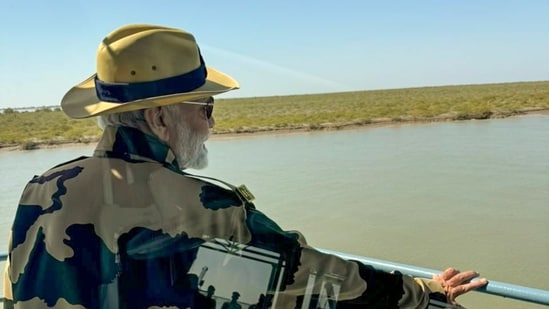 Prime Minister Narendra Modi celebrated Diwali with Border Security Force , Army, Navy, and Air Force personnel near Indo-Pak border in Kutch, Gujarat, Oct 31, 2024 (File photo)
Prime Minister Narendra Modi celebrated Diwali with Border Security Force , Army, Navy, and Air Force personnel near Indo-Pak border in Kutch, Gujarat, Oct 31, 2024 (File photo)
In the Jean-Jacques Annaud film based on William Craig’s 1973 nonfiction book Enemy at the Gates: The Battle for Stalingrad, Nikita Khrushchev, immediately after arriving in Stalingrad front as the new principal commissar, deputed by Joseph Stalin to boost Soviet morale after the defeat in the Second Battle of Kharkov at the hands of the Sixth Army of the Wehrmacht during the German summer offensive of 1942, took a meeting of the commanders of the Red Army formations comprising the 62nd, 63rd, and 64th Armies to apprise them of Stalin’s famous Order No 227 dated July 2 instructing the defence of Stalingrad at all costs.
The English actor and film director Bob Hoskins in the role of Khrushchev threatened the commanders, per the film, that Stalingrad was not like any other city in the USSR, for, it bore ‘the name of the boss’. The Southwestern Command of the Indian Army headquartered in Jaipur will not face such a predicament, as Sir Creek, the 96-km estuary flowing into the Arabian Sea and the westernmost point in Gujarat bordering Pakistan which is witnessing tensions lately, is named after an obscure British representative of the colonial era.
However, it is crucial to know as a tidal wave of ‘cultural nationalism’ is sweeping India that the original name of Sir Creek was Banganga in Sanskrit. Legend says Vaishno Devi created the tributary with an arrow and bathed in it, washing her hair, hence the river is also known as Bal Ganga — bal meaning ‘hair’ in Hindi.
Over the period between 1970s to 1990s when I handled Pakistan affairs in the MEA in different capacities during my three assignments at headquarters, the greatest pleasure was always in the access they gave to the fabulous archival materials that have never seen the light of day (and probably never will) stored in the vaults of South Block, which would punctuate the largely unproductive, frustrating and unremittingly tense routine in the IPA Division. I was always intrigued by the Sir Creek issue, which fitted the description of a low-hanging fruit in the deeply troubled India-Pakistan relationship, forever ripe for plucking but forever left untouched for some mystical reasons that was impossible to fathom at my level.
Sir Creek used to be a muddy, uninhabited marshland in the Rann of Kutch and nothing more than that. But that was before rare earths and Artificial Intelligence seized human imagination. Today, “The Sir Creek dispute is no longer only about boundary lines but also about energy security, maritime rights, and the risk of combined strategic pressure from Pakistan and China,” as one commentator argues. According to him, “Intelligence reports have highlighted heavy Pakistani military activity near the creek.” There are of course no means of fact-checking in that forlorn region, especially during the monsoon season when the tributary whimsically keeps changing direction.
However, Sir Creek — or Siachen conflict, for that matter, yet another ‘low-hanging fruit’ — served a vital purpose as a quintessential wind vane that turns to head into the wind of the India-Pakistan adversarial relationship. To use another metaphor from the animal kingdom, it is like Hippos who spend much of their day submerged in water or mud to stay cool, appearing slow and inactive, but are potentially unpredictable, territorial, and extremely aggressive.
Time present is one such moment when Operation Sindoor is still simmering in the cauldron. Defence Minister Rajnath Singh, during a visit on October 2 (Dussera day) to the Kutch region warned Pakistan that “a route to Karachi passes through Sir Creek” alluding, perhaps, to the1965 war. As sure as night follows the day, yesterday, hardly five days after Rajnath Singh spoke, his Pakistani counterpart Khawaja Asif warned that “chances of war with India are real.”
In response to a question during a TV interview, Minister Asif said Pakistan was keeping its guard and watching the situation, adding that Pakistan would likely achieve more favourable results in the event of a war with India. “I do not want escalation, but the risks are real, and I am not denying that. If it comes to war, God willing, we will achieve a better result than before,” he said.
Minister Asif also claimed, with an eye on the Trump administration perhaps, that the strategic balance in the region is today favourable to his country as compared to India. Asif then took a combative tone to give a history lesson that India was never a united nation, except briefly under Mughal emperor Aurangzeb, a historical figure that Hindu nationalists love to hate, and that Pakistan was created in the name of Allah and stood united during the May confrontation despite several internal issues. “At home, we argue and compete. In a fight with India, we come together,” he reminded us, which is probably true.
Such incendiary rhetoric (on both sides) can only trigger a cycle of mutual animosity that feeds itself. Naturally, going forward, one would shudder to think about a full-fledged India-Pakistan war that will most certainly hurt our economy seriously, coming on top of the fallouts of the US tariffs. Isn’t there some way to put to use the DGMO hotline for confidence-building instead of riding the high horse and rhetorically navigating a road to Karachi from Gujarat?
It costs nothing, after all, and may cool down tensions. The point is, raw intelligence is mostly undependable, and the marshy Creek region so soon after the monsoon is, logically speaking, an improbable terrain for either side to create new facts on the ground.
The big question still remains, though: Is India lurching from one foreign-policy crisis to another ever since the US-backed regime change in Bangladesh orchestrated by the Biden administration? The image of India in the international community through the past 3-year period in the US media has already been rather dismal — an irresponsible, bombastic Third World nation which dared to commit transnational crimes and has an appalling human rights record.
The sad part is that although the present government had inherited from the previous Congress government in 2014 a somewhat predictable relationship with Pakistan, it opted for a ‘muscular’ Pakistan-centric foreign policy. Any excessive zeal to whip up jingoism for electoral purposes must be held to account, both at the civilian and an increasingly politicised military level.
